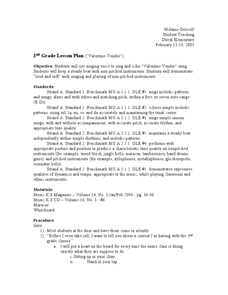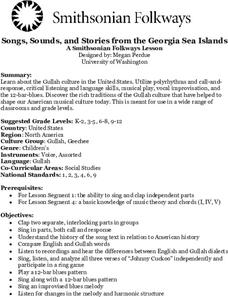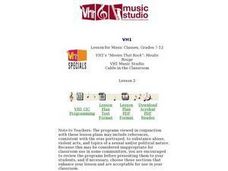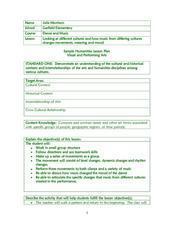Curated OER
High School Lesson Plan
Students compose and arrange music within specific guidelines. They # identify and explain compositional devices and techniques used in a musical work. They compare and contrast the use of those techniques between different compositions.
Curated OER
Grade 2: Music/Valentine's Day
Play and sing a Valentine's song with your second graders. They'll follow along allow as you demonstrate how to sing and keep a steady beat on non-pitched percussive instruments. While the music instructional activity has a Valentine...
Curated OER
Transferring Rhythmic Patterns From Music to Movement
Students identify and demonstrate movement elements in relation to musical notation. They clap to rhythms, beat on drums, match musical notes to speech patterns and use the rhythms of the their names to create a dance.
Lauren Kitchin
Singing in the Classroom
Those new to the Kodály Method of music instruction, as well as experienced educations, will find everything they need in a resource designed to launch a five-week vocal music program. Packed with warm ups, games, activities, and...
Curated OER
Independent Harmonies
Independent harmonies, homophonic music, intervals, and melody are all part of music theory and practice. Prepare your budding musicians for the big time with these activities focused on playing with accompaniment. This lesson is...
Curated OER
Lesson: Paul Chan: "Score for the 7th Light"
Music, art, and poetry coalesce in a single exhibition, and in a single lesson plan. Critical thinkers analyze the Fluxus art movement as it's seen in the work of Paul Chan's 7 Lights. They consider the use of poetry and music in his...
Curated OER
Same and Different Through Music and Art
This instructional activity is intended for a music class but would be a great way to teach compare and contrast to any class. Kindergarteners dance the Hokey Pokey to four different styles of music and examine two paintings of Humpty...
Curated OER
Elementary My Dear Dancer-Foundation Lesson
Students participate in dance choreography. In this choreography lesson, students classify elements of choreography. Students collaborate in small groups and compose choreography.
Smithsonian Institution
Songs, Sounds and Stories from the Georgia Sea Islands
American music is the result of the influence of many cultures, including the traditions brought by the African slaves. Young scholars study the polyrhythms, the call-and-response format, and the vocal improvisations of the Gullah...
Amani Project
Harmony Break! Finding Emotions With Music
Gather the entire family (or class members) for a fun Harmony Break! A volunteer thinks of a color from their Mood Meter that they will express by singing, playing an instrument, or performing a dance. After the performance, the audience...
New Class Museum
Lesson: Elizabeth Peyton: Portraits: Androgyny in Contemporary Culture
Portraiture, artistic expression, romanticism, and androgyny are discussed in a thought-provoking activity. Upper graders first discuss and examine the history of portraiture and the elements common to the Romantic style. Then they turn...
Curated OER
Identifying the Beat
Sixth graders listen to various songs. In this musical properties lesson, 6th graders work in groups to identify musical selections, practice tapping the beat, review time signatures, and identify the meter of different songs.
VH1
Lesson 3: Behind the Movie Chicago
In small groups and then as a class, young musicians compare and contrast two pieces from the musical film Chicago. They pair up to look at the elements that make each piece similar and define the elements or arrangements that make them...
Curated OER
Lesson: American Idyll
Using the painting, Childhood Idyll for inspiration, learners reflect on things that are idealized. They focus in on pop music and pop idols, write a song, and perform it in front of the class, American Idol style.
Curated OER
Composing Music
Students compose music with musical instruments, and write the proper notation for the songs they have created.
Curated OER
A Musical Textures Activity
Students identify textures in music. In this music appreciation lesson, students listen to a variety of classical music pieces and identify components of musical textures including monophony, homophony, polyphony, and heterophony.
VH1
Lesson 2: Moulin Rouge
The pop movie Moulin Rouge was based on the opera La Boheme. Learners watch the last 30 minutes of each musical to compare and contrast social opposites. They'll first discuss the social differences of the main characters and how those...
Curated OER
Using Harmonic Vision’s Music Ace Software to Reinforce Basic Music Skills
If you have access to Harmonic Vision’s Music Ace Software, then this lesson could work for you. Kindergarteners use the video music software to place, identify, and read musical notes. They listen in and identify both high and low...
Curated OER
Band On Line
In 1996, using the Internet to enhance learning was a new innovation. While the lesson here is a bit outdated, it could still provide a basic understanding of how technology can enhance music appreciation. Members of the school band...
Curated OER
Responding Syllables: Reading and Music
Shell Silverstein’s “Sick” provides an opportunity for kids to demonstrate their understanding of syllables and phonemes. The class creates a list of descriptive words used in the poem that have more than one syllable, and brainstorm how...
Curated OER
Grand Canyon Suite
Take a trip to the Grand Canyon! Lesson one explores how Ferde Grofe painted a musical landscape of America when he wrote the Grand Canyon Suite. Learners then examine art that shows the Grand Canyon in lesson two. Finally, lesson three...
Curated OER
Looking at different cultures and how music from differing cultures changes movements, meaning and mood
Each of the three dance lessons included here will get your class moving. The first lesson allows learners to explore how music and movement differ in meaning depending on cultural context. Lesson two gives them an opportunity to create...
Curated OER
Round and Dance Music
Third graders recognize a round in singing groups and apply to choreography movements. In this rounds lesson, 3rd graders memorize movements with songs at specific places. Students perform a three part round.
Curated OER
My (musical) Valentine
Get out those bells, sand blocks, and sticks! Your kindergarteners use their singing voices to ask and answer friendly questions while keeping rhythm. They take turns in a group and in pairs singing questions and answers while keeping...
























